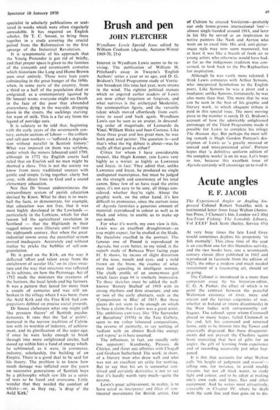Scots myths
STUART HOOD
A History of the Scottish People: 1560- 1830 T. C. Smout (Collins 75s) Few societies can be so dominated by myths as are the Scots. There is the cluster of legend and anecdote that generally passes for Scottish history. There is the Highland myth, invented by Sir Walter Scott, given royal approval by George III when, on his Edinburgh visit, he appeared in full Highland fig, and perpetuated to this day by English landowners. At least it has the Merit of being a dollar-earner, selling to gullible tourists bogus tartans, dirks, skean dubhs, sporrans and cairngorm clasps.
Closely related is the Jacobite myth, born a generation or more after the '45 rebellion. It starts with songs like 'Charlie is my darlin' and 'Over the sea to Skye', written by Edinburgh ladies in a flood of political sentimentality and is perpetuated in equally sentimental historical romances. There is the myth. of the Highland regiments — those mercenaries who, in the case of the Black Watch, were first used to keep down their 'own kith and kin' and then exported to subdue the tribes on the frontiers of Empire. There is the egalitarian myth of the Scots as a sturdy peasantry, supping their porridge, breeding sons as good as the next man or maybe better, who would stock the pulpit, the courts, the schools. There is the myth of Scottish education, that narrow pedagogic system based on the wholesale use of the tawse. There is the talk of the national heritage in a country which still pulls down its architectural monuments and, having had some of the worst slums in Europe, re- places them with municipal housing that enjoys the same dishonourable distinction.
It has always been extraordinarily difficult for anyone wishing to get below the surface of this sugar-coated confection to know where to lay his hands on facts: facts about social structures, about living conditions, about the economic growth that lifted Scot- land out of its backwardness and into the modern world. They were available for the specialist in scholarly publications or seat4 tered in works which were often singularly unreadable. It has required an English scholar, Dr T. C. Smout, to bring them together in a study covering the crucial period from the Reformation to the first upsurge of the Industrial Revolution.
It is symptomatic of his approach that the Young Pretender is got rid of briefly, and that proper space is given to the famines of the sixteenth and seventeenth centuries which historians like Lang and Hume Brown pass over entirely. These were lean years culminating in the great hunger of the 1690s when, in some parts of the country, from a third to a half of the population died or emigrated; as a contemporary (quoted by Dr Smout) wrote, everyone might see Death in the face of the poor that abounded everywhere, dying in the wayside, dropping down in the streets, the sucklings starving for want of milk. This is a far cry from the legend of porridge oats.
It is salutary to be told that, beginning with the early years of the seventeenth cen- tury. certain sections of labour — the colliers and salt-pan workers — 'suffered a degrada- tion without parallel in Scottish history.' What was imposed on them was serfdom, under which the miners laboured until 1799, although in 1772 the English courts had ruled that on English soil no man might be deemed a slave. This is not the society we know from more traditional sources with gentle and simple living together, clarty but cosy, with direct lines to God and a sound elementary education.
Not that Dr Smout underestimates the extraordinary system of parish education devised by Knox. What he does is to mars- hall the facts, to demonstrate, for example, that education was not free, that it was most highly developed in the Lowlands — particularly in the Lothians, which for that reason led the agricultural revolution in Scotland — that the Highlands in their ragged misery were illiterate until well into the eighteenth century. that when the great industrial towns arose the parochial system proved inadequate. Accurately and without malice he pricks the bubbles of self-con- gratulation.
He is good on the Kirk, on the way it deflected 'effort and talent away from the enrichment of secular life,' on its class struc- ture and the way that structure was reflected in its schisms, on how the Patronage Act of 1712 made the ministers the creatures of the heritors, the local lairds and big farmers. It was a pattern that lasted for more than a couple of centuries and was still un- broken in the village where I was born: there the Auld Kirk and the Free Kirk had con- gregations defined on precise social grounds.
Dr Strout elaborates what one might call 'the pressure theory' of Scottish psycho- dynamics. It runs that the lad o' pairts', nurtured in the narrow tradition of Calvin- ism with its worship of industry, of achieve- ment, and its glorification of the super-ego, if once he were lucky enough to break through into more enlightened circles, had stored up within him a fund of energy which he sublimated, as it were, in commerce, industry, scholarship, the building of an Empire. There is a good deal to be said for his theory. The problem is to know how much damage was inflicted over the years on successive generations of Scottish boys by a philosophy which saw life as a series of tests to be faced and overcome. Little wonder that they needed the comfort of whisky—or, as they say, 'a chap o' the Auld Kirks'



































 Previous page
Previous page